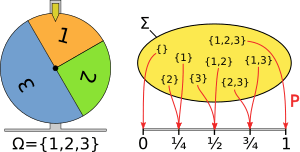Probability space facts for kids
A probability space is a special mathematical model that helps us understand and describe scientific experiments. It's like a blueprint for figuring out what might happen when you do something random, like rolling a dice or spinning a wheel.
This model has three main parts:
- A sample space: This is a list of all the possible things that could happen in your experiment. We often use the symbol
 (that's a Greek letter, Omega) for the whole sample space. Each single thing that can happen is called an outcome, and we use
(that's a Greek letter, Omega) for the whole sample space. Each single thing that can happen is called an outcome, and we use  (little omega) for that.
(little omega) for that. - A set of events: An event is a group of one or more outcomes. For example, if you roll a dice, getting an "even number" is an event because it includes the outcomes 2, 4, and 6.
- A function that gives a probability to each event: This function tells us how likely each event is to happen.
An outcome is just one result from your experiment. But often, we care more about groups of outcomes, which we call events. The collection of all these possible events is sometimes called a σ-algebra, and it's written as  . Finally, we need to know how likely each event is to occur. This is where the probability measure function, called P, comes in. It assigns a number (the probability) to each event.
. Finally, we need to know how likely each event is to occur. This is where the probability measure function, called P, comes in. It assigns a number (the probability) to each event.
Once we set up a probability space, we imagine that something "chooses" one outcome from the sample space  . Any event in
. Any event in  that includes this chosen outcome is then said to "have happened." If you were to repeat the experiment many, many times, the number of times each event occurs would match the probabilities given by the function P.
that includes this chosen outcome is then said to "have happened." If you were to repeat the experiment many, many times, the number of times each event occurs would match the probabilities given by the function P.
The idea of a probability space was created by a famous Soviet mathematician named Andrey Kolmogorov in the 1930s. He also came up with other basic rules for probability.
Contents
What is a Probability Space?
A probability space helps us study things that are uncertain. Think of it as a complete plan for any experiment where the result isn't always the same. It makes sure we cover all possibilities and understand how likely each one is.
Understanding Outcomes and Events
The Sample Space: All Possibilities
The sample space ( ) is like a complete list of everything that can happen in your experiment.
) is like a complete list of everything that can happen in your experiment.
- If you flip a coin, the sample space is {Heads, Tails}.
- If you roll a standard six-sided dice, the sample space is {1, 2, 3, 4, 5, 6}.
Each single item in this list is an outcome ( ).
).
Events: Groups of Outcomes
An event is a specific result or a group of results you are interested in.
- When flipping a coin, "getting Heads" is an event.
- When rolling a dice, "getting an even number" is an event. This event includes the outcomes {2, 4, 6}.
- "Getting a number greater than 4" is another event, including {5, 6}.
Events are always made up of outcomes from the sample space.
The Probability Measure: How Likely?
The probability measure (P) is a special rule that tells us how likely each event is to happen. It gives a number between 0 and 1 to every event.
- A probability of 0 means the event will never happen.
- A probability of 1 means the event will always happen.
- A probability of 0.5 (or 50%) means the event is equally likely to happen or not happen.
For example, if you roll a fair dice:
- The probability of rolling a 1 is 1/6.
- The probability of rolling an even number (2, 4, or 6) is 3/6, which simplifies to 1/2.
Why Do We Use Probability Spaces?
Probability spaces are important because they give us a clear and organized way to think about random events. They help scientists, statisticians, and even game designers predict what might happen. By defining the sample space, events, and their probabilities, we can make informed decisions and understand risks.
For example, in weather forecasting, a probability space helps predict the chance of rain. In medicine, it helps understand the likelihood of a treatment working.
Related pages
See also
 In Spanish: Espacio de probabilidad para niños
In Spanish: Espacio de probabilidad para niños


